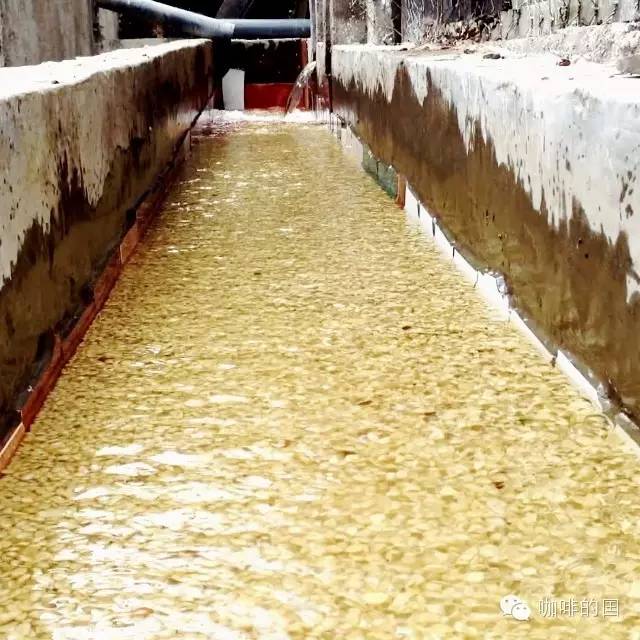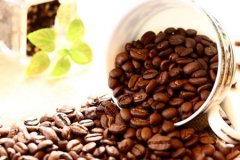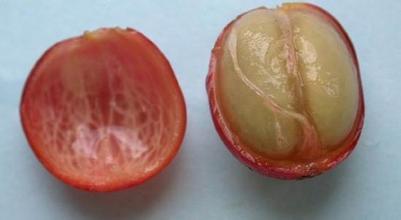Treatment method of coffee washing raw bean-- water washing method of coffee raw bean
Water washing method for the treatment of raw beans
Because of the lack of sufficient sunshine in the West Indies, the Dutch introduced the "washing method", also known as "WIB", around 1740, which is different from the traditional sun method, also known as "OIB". Coffee beans exported from Java are often marked "WIB", which means "washed beans". The treatment steps of the washing method are as follows:
1. Select beans: put the harvested fruit in a water tank and soak for about 24 hours. At this time, ripe fruit will sink, while immature and overripe fruit will float up and can be removed.
2. Remove the pulp: use a machine to remove the fruit and pulp, leaving only the coffee beans wrapped in endocarp. At this time, there is a layer of mucous membrane on the outside of the beans, and the process of washing is to wash this layer of mucous membrane.
3. Fermentation: the adhesion of the mucous membrane is very strong and it is not easy to remove. It must be placed in the tank for about 18-36 hours to ferment and decompose the mucous membrane. There are two methods of fermentation, namely wet fermentation and dry fermentation. As the name implies, the former adds water and the latter does not add water. In the process of fermentation, the seed and internal pulp will produce special changes, which is a step that most affects the flavor of coffee in water washing. Some farms add hot water or enzymes to speed up fermentation, which has a negative impact on quality and is not popular with selected coffee lovers. Sigri, a famous coffee farm in Papua New Guinea, prides itself on its unique washing method. Their fermentation period lasts for 3 days and is washed with clean water every 24 hours, so they can produce delicious Sigri Coffee.
4. Washing: farms that use the washing method must build washing ponds and be able to introduce an endless supply of live water. During the treatment, the fermented beans are put into the pool and passed back and forth, using the friction of the beans and the power of running water to wash the coffee beans until smooth and clean.
5, drying: after washing, at this time, the coffee beans are still wrapped in the pericarp, the moisture content is up to 50%, must be dried, the moisture content is reduced to 12%, otherwise it will continue to ferment, mildew and rot. The better treatment is to use sunlight to dry, although it takes 1 to 3 weeks, but the flavor is very good and very popular. In addition, some places use to stimulate drying, greatly shorten the processing time, so that the flavor is not as good as sun-dried coffee. The aforementioned Sigri Farm uses the hot equatorial sun to dry its coffee beans. No wonder its Sigri Coffee has won quite a lot of praise in the select coffee market.
6. Shelling: the dried beans can be stored in a warehouse or handed over to the factory for shelling to remove endocarp and silver film.
7. Selection and grading: like the sun-drying method, washed coffee beans are selected and graded to remove defective beans, ensure better quality, and then give them to exporters to sell around the world.

Important Notice :
前街咖啡 FrontStreet Coffee has moved to new addredd:
FrontStreet Coffee Address: 315,Donghua East Road,GuangZhou
Tel:020 38364473
- Prev

Brief introduction of Guatemalan Fine Coffee is Guatemalan coffee good? Characteristics of Guatemalan Coffee
Guatemala is bordered by Mexico to the north, Honduras and El Salvador to the south, the Caribbean to the east and the Pacific Ocean to the west, with tropical rain forests, volcanic geology, plateau valleys and changeable microclimate. The average elevation of dangerous countries is high, with coffee belts distributed over 1500 meters and between 14 and 16 degrees north latitude, it is easiest to grow extremely hard beans, all of which are washed, 45% of which are washed.
- Next

Coffee tree coffee flower coffee mature coffee spice
Coffee tree, a perennial evergreen shrub or small tree of Rubiaceae, is a horticultural perennial cash crop with the characteristics of fast growth, high yield, high value and wide market. Wild coffee trees can grow to a height of 5 to 10 meters, but coffee trees planted on the manor are often cut to less than 2 meters in order to increase their fruit and facilitate harvesting. The opposite leaves of coffee trees show
Related
- Detailed explanation of Jadeite planting Land in Panamanian Jadeite Manor introduction to the grading system of Jadeite competitive bidding, Red bid, Green bid and Rose Summer
- Story of Coffee planting in Brenka region of Costa Rica Stonehenge Manor anaerobic heavy honey treatment of flavor mouth
- What's on the barrel of Blue Mountain Coffee beans?
- Can American coffee also pull flowers? How to use hot American style to pull out a good-looking pattern?
- Can you make a cold extract with coffee beans? What is the right proportion for cold-extracted coffee formula?
- Indonesian PWN Gold Mandrine Coffee Origin Features Flavor How to Chong? Mandolin coffee is American.
- A brief introduction to the flavor characteristics of Brazilian yellow bourbon coffee beans
- What is the effect of different water quality on the flavor of cold-extracted coffee? What kind of water is best for brewing coffee?
- Why do you think of Rose Summer whenever you mention Panamanian coffee?
- Introduction to the characteristics of authentic blue mountain coffee bean producing areas? What is the CIB Coffee Authority in Jamaica?

